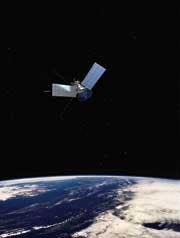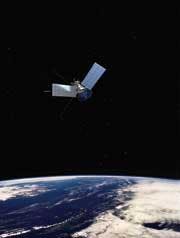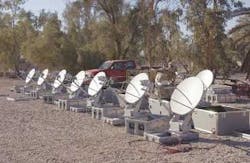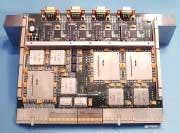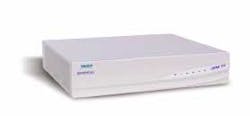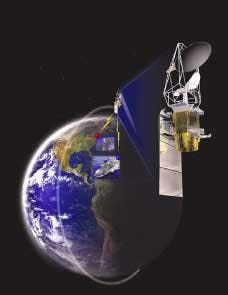Satellite designers see Internet protocol as the future enabling technology in satellite communications, from Earth observation to military applications.
By John McHale
In much the same way that Internet technology has revolutionized communications in the workplace, satellite designers in the commercial and military fields expect it to do the same for satellite communications.
Using TCP/IP technology for satellite communications would bring the ability to have office-like connectivity in even the most remote part of the Earth.
TCP/IP (transmission control protocol/Internet protocol), developed under contract from the U.S. Department of Defense (DOD), lays out the rules of how the Internet formats and transmits data. It controls how data bytes move, and makes sure the information received is correct. TCP controls how data bytes move, and makes sure the information received is correct, while IP serves as the electronic post office by ensuring that messages get to the right address or addresses.
Data users demand increasing amounts of information every day, and current satellite routing technology cannot satisfy all those needs, hence the turn toward TCP/IP says Rick Skinner, vice president of transformational communications for Lockheed Martin Space Systems in Sunnyvale, Calif.
TCP/IP along with UDP/IP (User Datagram Protocol/IP) are the Internet protocols in use today, according to a white paper from ViaSat in Carlsbad, Calif., "Using Satellites for IP Networking." When choosing between these protocols, systems designers balance their needs for speed and data accuracy. In general, TCP puts a priority on accuracy over speed, while UDP places more importance on speed than on accuracy.
"TCP needs the receiver to confirm the successful receipt of data before additional data is transmitted. If errors in transmission occur TCP automatically retransmits the correct data," the paper states. "Conversely, (UDP/IP) is an unreliable, connectionless protocol. There is no feedback mechanism from receiver to transmitter and data may be received in error. But, because there is no feedback path with UDP, data can be transmitted much more quickly."
Despite its benefits, TCP/IP connections over geostationary satellites have one major drawback to TCP/IP connections over geostationary satellites — the normal half-second delay of communicating over a satellite. "The bottom line is that performance can vary depending on the number of transit points and the congestion of these links," says the paper.
TCP/IP in Iraq
Experts at Lockheed Martin Space Systems and engineers at ViaSat have already fielded IP satellite hardware for a coalition military network in Iraq, which will use commercial satellites to provide secure voice and data services, voice-over IP to integrate telephone and data on a common network, and connections between coalition forces, ViaSat officials say. The order is for a hub and 20 remote terminals.
This network is expected to give coalition forces access to new network-centric services that would otherwise only become available with the future launch of the U.S. Air Force's Transformational Communications MILSATCOM (TCM) space segment architecture in 2011.
The TCM space segment will consist of the five-satellite Transformational Satellite Communications constellation — better known as TSAT — and the three-satellite Advanced Polar System (see "Optical links are key to next-generation military communications satellite").
The coalition military network is designed to support more than 1,000 telephone lines as well as fast "cable modem–like" data access to the coalition Wide Area Network (WAN) backbone. "The equipment will help free up tactical signal soldiers in Kuwait and Iraq," says Marc Agnew, ViaSat's vice president of Government Broadband Systems. "This is our second network for Iraq featuring an Internet protocol bandwidth-on-demand capability that reduces satellite bandwidth requirements."
The TCP/IP technology basically turns the battlefield or brigade headquarters into an office environment in terms of the equipment, says Rick Vandermeulen, director of government broadband for ViaSat. They have anywhere from eight to 16 telephone lines and eight to 16 personal computers, he adds. Prior to TCP/IP Army personnel were narrowband tactical radios for their communication, Vandermeulen says.
The Iraq application also provides Lockheed Martin and ViaSat engineers feedback on how Army personnel are adopting to this technology, Lockheed Martin's Skinner says.
The bandwidth savings produced by ViaSat LINKWAY and LinkStar satellite modems can reduce the cost of leased commercial satellite bandwidth as compared to the Single Channel Per Carrier (SCPC) networks they replace. LINKWAY and LinkStar very small aperture terminals (VSATs) dynamically allocate bandwidth so remote stations can share access to the network. The VSATs also adjust the size of the satellite channel to match data traffic. The work under this contract will be performed over the next six months at ViaSat's facilities in Carlsbad, Clarksburg Md., and Norcross Ga.
VSE Corp. in Alexandria, Va., is using ViaSat LINKWAY satellite terminals for military camera crews to transmit video and still imagery from forward military areas to headquarters, command locations in the field, or back to the U.S. quickly and securely.
This network features LINKWAY. IPTM VSATs, self-pointing antennas, and special power systems so users can set up and operate the system rapidly in any location. The system will help users capture and edit images, and encode video in real time.
Transformational Communications MILSATCOM
TCM represents the next step toward moving the DOD wideband and protected communications satellite architecture into one network that comprises several satellite, ground, and user segment components, Lockheed Martin officials say. The system will network mobile warfighters, sensors, weapons, communications command and control nodes located on unmanned aerial vehicles, piloted aircraft, on the ground, in the air, at sea or in space via TCP/IP.
TCM is one of several elements that make up the Transformational Communications architecture that the national security space community has developed over the last two years. TCM will provide thousands of users with significantly improved, highly mobile, beyond line-of-sight protected communications to support the future battlefield.
"TCM will bring a significant increase in bandwidth and joint service interoperability in a networked environment," says Dan Pearson, president of Defense Programs at the Harris Corp. Government Communications Systems Division in Palm Bay, Fla. "It will be the enabler for DOD's vision of network-centric warfare for the tactical and mobile user."
TCM project managers also will look at using TCP/IP to make communications secure not only from jamming but also from hackers, Skinner says.
"Technologies like laser communications and routing processors will enable warfighter access to a secure, protected, global broadband network, eliminating bandwidth as an operating constraint," says Stuart Linsky, program manager, transformational communications at Northrop Grumman Space Technology in Redondo Beach, Calif.
A Lockheed Martin Space Systems/Northrop Grumman team will compete with a team led by Boeing Satellite Systems in El Segundo, Calif., for the contract, which will be awarded in 2006 by the MILSATCOM Joint Program Office at the U.S. Air Force Space and Missile Systems Center at Los Angeles Air Force Base, Calif. This effort will culminate with a multibillion-dollar development contract to one contractor in 2006 with the first satellites to be launched in 2011.
"Future warfare will be dominated by the control of information. A successful communications, command-and-control and decision-making environment will depend on the exploitation of knowledge, and speed of action based on that knowledge," says George Muellner, senior vice president and general manager at Boeing Air Force Systems. Boeing officials declined to comment further for this story.
The Lockheed Martin/Northrop Grumman team also includes Rockwell Collins, General Dynamics Advanced Information Systems, L-3 Communications, Stratogis, Cisco, C&H Associates, and ViaSat in an effort to bring together industry leaders and expertise in all aspects of the end-to-end architecture. Lockheed Martin will serve as the prime contractor and systems integrator for the TCM Space Segment. Northrop Grumman will provide the satellite' transformational payloads, end-to-end communication systems engineering, and payload ground processing.
Boeing Satellite Systems is working with Raytheon, Ball Aerospace, General Dynamics, IBM, L-3 Communications, Cisco Systems, BBN Technologies, Hughes Network Systems, Lucent Technologies, Harris, EMS Technologies, and Alpha Informatics.
Space Network Router
Actual IP equipped satellites may be a few years off, but Spectrum Astro engineers in Gilbert, Ariz., are already working with officials at NASA Earth Science Technology Office under the Advanced Information Systems Technology (AIST) Program at Goddard Space Flight Center in Greenbelt, Md., to develop spacecraft network hardware called Space Network Router (SNR).
The SNR program evolved from a previous NASA Computing, Information, and Communications Technology program called Space Network Devices (SND). The contract will be managed at NASA Glenn Research Center (GRC) in Dayton, Ohio.
The objective of the SND task is to develop prototype Internet protocol (IP) compliant network hardware that is interoperable with other terrestrial and non-terrestrial hardware, for use on manned and unmanned space vehicles, NASA GRC officials say. This technology development will be a network interface card and associated hub based on the 10/100 megabits per second Ethernet commercial off the shelf (COTS) standard.
Other benefits include:
- seamless operation and integration of several data formats and transmission of increased user services;
- at least a factor of 2 reduction for IP-based vs. customized hardware interface development;
- at least a factor of 10 increase over traditional space protocols for normalized data throughput with existing size, weight, and power hardware requirements; and
- reduced NASA Enterprise mission costs and streamlined implementation through modularity and reusability of hardware and software components, NASA GRC officials say.
SNR is to develop TCP/IP-compatible network hardware for space applications. Ethernet local area network (LAN) devices for space, including a 10/100-megabit-per-second network interface controller and 100-megabit-per-second hub, were developed in SND program. SNR builds on the work of SND, Spectrum Astro officials say.
For SNR, components developed on SND will be building blocks for a space-based router. The space router will interconnect networks on a spacecraft and lays the foundation for seamless interconnectivity among spacecraft in a constellation as well as between spacecraft and the ground, company officials say. Leveraging commercial standards for use in space enables spacecraft "that are more robust and less costly to design, test, and operate," says Jim Joseph, Spectrum Astro SNR program manager.
Even though commercial technologies and equipment are saving money, the satellites themselves are still expensive custom endeavors, and rarely are multiple versions of a satellite designed, says W. David Thompson, president and CEO of Spectrum Astro. Thompson says that field-programmable gate arrays (FPGAs) are improving performance by increasing density. One of Spectrum Astro's major FPGA suppliers is Actel of Sunnyvale, Calif.
Spectrum Astro-built Coriolis satellite completes successful first year on orbit
Officials at Spectrum Astro in Gilbert, Ariz., recently announced that the Coriolis satellite has completed its first year of on-orbit payload operations.
During this time, the Coriolis Spacecraft availability for the support of its payload operations was 99.3 percent, company officials claim. Spectrum Astro engineers designed and manufactured the spacecraft bus and integrated the payloads for this Department of Defense Space Test Program research satellite.
In the past year, Coriolis has orbited Earth more than 5,000 times and has sent more than 12 terabits of science data to ground receiving stations. Coriolis launched on Jan. 6, 2003 and completed its orbit transfer and on-orbit checkout 30 days later.
Coriolis supports two payloads including the Windsat instrument, which gathers data to facilitate prediction of wind speed and direction at or near the surface of the Earth's oceans. This information benefits the Navy's planning of operations and improves weather forecasting. Coriolis also carries the Solar Mass Ejection Imager (SMEI), which provides early warning of solar coronal mass ejection risks to Earth orbiting satellites, as well as to communications and power grids.
Currently, Spectrum Astro engineers perform a lead role in the engineering management of the spacecraft bus for the Coriolis mission.
Coriolis is a U.S. Department of Defense Space Test Program, Space and Naval Warfare Systems Command, and Air Force Research Laboratory mission to demonstrate remote sensing of global wind vectors using the Microwave Polarimetric Radiometry technique, plus risk reduction for the Conical Microwave Imager Sounder element of the National Polar-orbiting Operational Environmental Satellite System.
In addition, the mission is to demonstrate more rapid and accurate predictions of geomagnetic disturbances to orbiting satellites through continuous observation of solar coronal mass ejections. Spectrum Astro built the spacecraft and integrated the instruments under a NASA Goddard Space Flight Center Rapid Spacecraft Acquisition (RSA I) Contract.
Federal dollars for Earth observation
Retired Navy Vice Adm. Conrad C. Lautenbacher, undersecretary of commerce for oceans and atmosphere and NOAA administrator, recently announced President Bush's proposed fiscal year 2005 budget for the Commerce Department's National Oceanic and Atmospheric Administration (NOAA) in Washington.
Lautenbacher says NOAA's request $3.4 billion, an increase of $146.9 million over the FY 2004 request.
"This proposed budget maintains and enhances the services and programs for our scientific understanding of the oceans and atmosphere and allow us to sustain the nation's environmental health and economic vitality," says Lautenbacher. "This budget request allows us to develop the science necessary to improve weather, water and ecosystem forecasts of the future, as well as give policy makers the data they need to make important decisions related to climate change."
Highlights include funding increases of:
- $10.7 million for sustained ocean observation systems;
- $6.6 million for a five-year study on aerosols, which are tiny particles in the atmosphere that act to either heat or cool the atmosphere and represent an area of scientific uncertainty;
- $6.5 million for a carbon cycle atmospheric observing system to study carbon uptake in and around North America;
- $3.4 million for the Comprehensive Large Array Data Stewardship System (CLASS, which will enable development of a state-of-the-art archive management system with a robust, large-volume storage and retrieval system necessary for sharing data with the scientific community;
- $5.3 million to expand the use of satellite monitoring of commercial fishing vessels for enforcement of fishing rules and collection of scientific data;
- $8.6 million for the charter of hydrographic survey vessels to map more of the nation's ports and coastal waterways; and
- $2 million is requested to make 90 more nautical charts available electronically.
The Electronic Navigational Charts program provides mariners a quick and safe method of navigating U.S. waters, and is a tool for rapid emergency response for hurricanes, shipwrecks, and homeland security concerns.
U.S. Navy selects Harris Advanced EHF Satellite communications terminal prototype
Officials at the U.S. Space and Naval Warfare Systems Command in San Diego recently chose Harris in Melbourne, Fla., to develop four prototypes for the next-generation Advanced Extremely High Frequency (AEHF) Navy Multi-band Terminal (NMT).
The U.S. Air Force Advanced EHF satellite program is a follow-on to the U.S. Department of Defense's (DOD's) Military Strategic, Tactical, and Relay communications satellite system, better known as MILSTAR.
"In the case of the Advanced EHF Navy Multi-band Terminal (NMT), there will be several different configurations supporting surface, submarine, and land-based missions. Having said that, all of the terminals will serve the same critical function: providing highly secure satellite communications connectivity to the DOD's constellation of AEHF, MILSTAR, and legacy processing satellites," says Dan Pearson, president of defense programs at the Harris Corp. Government Communications Systems Division (GCSD).
"Since AEHF satellites are 'protected' and highly secure, the terminal systems accessing them require a higher degree of reliability than more traditional systems. The Advanced EHF NMTs will enable its afloat and shore units to communicate from anywhere in the world via the Air Force satellites, as well as other military and commercial satellites, simultaneously," he continues. "The multiband, multimode terminals will provide deployed Navy commanders with secure command and control capability, as well as enhanced communications such as tactical data and imagery, real-time video, battlefield maps, and targeting information.
"The new terminals will be much more capable in the areas of speed, bandwidth, and flexibility in order to deliver the enhanced imagery, video and targeting information capability of the Advanced EHF satellites," Pearson says.
According to Pearson, key technologies and equipment that will be used in the program include improved modems and phased arrays.
Lockheed Martin–led team submits proposal for next-generation satellite communications system
A team led by Lockheed Martin Space System engineers in Sunnyvale, Calif., recently submitted a proposal to design and build the Mobile User Objective System (MUOS), a next-generation narrowband tactical satellite communications system for the U.S. Navy that will provide improved and assured communications for mobile warfighters.
The system will "expand the capacity for UHF communications and meet the need for 'comms on the move' as the military increasingly relies on light and mobile forces in theater," says Manny DiMiceli, vice president and MUOS program manager, Lockheed Martin Space Systems.
The team includes General Dynamics of Scottsdale, Ariz., and Boeing Satellite Systems in El Segundo, Calif.
The U.S. Navy Space and Naval Warfare Systems Command in San Diego, Calif., will award the contract in June 2004.
MUOS is a key element of the U.S. Department of Defense's Advanced Narrowband Communications system. Over the next two decades, MUOS will replace the current Ultra High Frequency Follow-On (UFO) system. The Navy's UFO satellites — the last of which was launched in December 2003 — currently provide narrowband tactical satellite communications to Joint Forces and Coalition partners. Spacecraft in the UFO system were launched aboard Lockheed Martin–built Atlas rockets between 1993 and 2003.
